East 11th Street in New York City, nestled in the vibrant East Village, is more than just another Manhattan thoroughfare. It’s a historical tapestry woven with threads of immigrant stories, architectural evolution, and community milestones. Recently, concerns have risen regarding the preservation of a significant block on this street, specifically between Third and Fourth Avenues. This area, identified by the New York City Landmarks Commission as a potential historic district as early as 2008, faces the threat of demolition to make way for modern development.
The Greenwich Village Society for Historic Preservation (GVSHP) proposed a landmark district encompassing several key buildings to safeguard this unique urban heritage. This proposal highlighted structures at 112-120 East 11th Street, 113 East 11th Street (formerly St. Ann’s Parochial School), 125 East 11th Street (Webster Hall), 122 East 11th Street/64 Third Avenue, and 93 Fourth Avenue (Cooper Station Post Office). These buildings collectively represent the diverse facets of working-class New York during the late 19th and early 20th centuries in the East Village, serving as spaces for residence, education, entertainment, and essential community services.
Unfortunately, despite the urgency emphasized by GVSHP, the Landmarks Preservation Commission (LPC) did not act on the landmark proposal. Demolition permits were subsequently approved for 112-120 East 11th Street, jeopardizing these 19th-century tenements. The potential loss of these Beaux Arts style buildings signifies a significant blow to the historical integrity of the East Village.
To truly appreciate the significance of East 11th Street, delving into its architectural and historical layers is essential. This block is a living museum, showcasing the transformation of New York City over centuries.
Architectural Highlights of East 11th Street: A Walk Through History
East 11th Street’s architectural landscape is a fascinating blend of styles reflecting different eras and purposes. From early 19th-century row houses to grand public buildings, the street tells a story of urban development and community growth.
From Row Houses to Tenements: The Story of 122 East 11th Street and 64 Third Avenue
The corner of East 11th Street and Third Avenue offers a glimpse into the early 19th century with the building at 122 East 11th Street/64 Third Avenue. Originally constructed as two Greek Revival style row houses in the 1830s, these structures initially served as first and second-class dwellings with storefronts. An 1853 map indicates their residential and commercial function in a developing neighborhood.
As the 19th century progressed and immigration to New York City surged, these row houses underwent “tenementization.” This transformation adapted them to house multiple families, reflecting the area’s shift towards a densely populated, working-class immigrant neighborhood. In 1958, the two buildings were combined, and in 1997, a fourth floor was added to 122 East 11th Street, illustrating the continuous evolution of these buildings to meet changing urban needs.
St. Ann’s Parochial School: Reflecting the Growth of the Catholic Community
Further east on 11th Street stands the former St. Ann’s Parochial School at 113 East 11th Street. The 19th century witnessed a rapid expansion of New York City’s Catholic community. By 1870, St. Ann’s parish had outgrown its existing facilities. Recognizing the need for a larger school, the parish acquired a former Baptist Church site on East 12th Street with land extending to East 11th Street.
This space allowed for the construction of a new parochial school, designed by the prominent architect Napoleon Le Brun. Le Brun was renowned for his design of numerous New York City firehouses, many of which are now landmarked. Opened in 1870, St. Ann’s Parochial School initially accommodated 560 students, serving the educational needs of the growing community. Although converted into apartments in 1978, the building’s facade retains significant original features, including a stone disc inscribed with “St. Ann’s Parochial School, 1870” and the outlines of separate entrances for boys and girls, a common design element of the era.
Webster Hall: A Legendary Social and Cultural Landmark
A cornerstone of East 11th Street’s cultural history is Webster Hall, located at 125 East 11th Street. Constructed in 1886-87 for Charles Goldstein and expanded with an annex in 1892, Webster Hall was designed by architect Charles Rentz, Jr. The original structure showcases Queen Anne style architecture, while the annex exhibits Renaissance Revival influences.
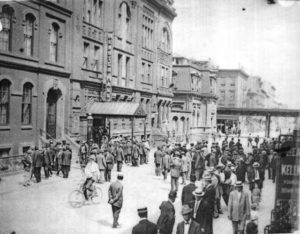 Webster Hall in 1913, historic photograph from the International News Service archives
Webster Hall in 1913, historic photograph from the International News Service archives
Webster Hall quickly became a vital community center and gathering place in Greenwich Village and the East Village. Throughout its history, it has hosted a wide array of events, including balls, dances, lectures, political rallies, concerts, and performances, particularly serving the working-class and immigrant communities of the Lower East Side. Recognized for its cultural significance, Webster Hall was designated a New York City Landmark in 2007, ensuring its preservation for future generations.
112-120 East 11th Street: Beaux Arts Tenements Facing Demolition
The block of 112-120 East 11th Street represents a significant collection of old law tenements, constructed starting in 1887 with No. 112, designed by William Graul. Graul was a prolific architect in New York City, known for diverse designs across various historic districts. Nos. 114, 116, 118, and 120 followed, designed by architects Julius Kastner and Oswald Wirz respectively. Wirz also designed the landmarked 56-58 Pine Street.
These five buildings replaced earlier row houses and exemplify the “dumbbell” plan typical of old law tenements. Predominantly designed in the Beaux Arts style, their facades retain much of their original classical ornamentation. Census records from the early 20th century reveal a diverse population of first and second-generation immigrant families, primarily from Germany, Italy, Russia, Spain, and Ireland, reflecting the area’s rich immigrant history and proximity to “Little Germany” (Kleine Deutschland).
The impending demolition of 112-120 East 11th Street underscores the vulnerability of these historic residential buildings and the potential erasure of the street’s architectural and social history.
Cooper Station Post Office: A WPA Era Landmark of Public Service
At the intersection of Fourth Avenue and East 11th Street stands the Cooper Station Post Office, built between 1936 and 1937. Constructed as part of a public works program during the Great Depression, it is one of twelve post offices built in New York City during the 1930s. Designed by William Dewey Foster, who also designed numerous other post offices, Cooper Station exemplifies the Classical Revival style.
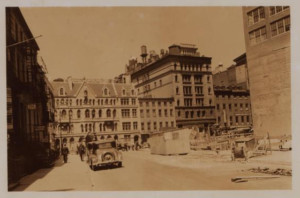 Photograph of the Cooper Station Post Office site before construction, from the NYPL collection
Photograph of the Cooper Station Post Office site before construction, from the NYPL collection
Its most distinctive feature is the curved facade at the corner, accentuated by a two-story colonnade of Doric columns. Cooper Station Post Office has served the East Village community for decades and was listed on the New York State and National Registers of Historic Places in 1982, recognizing its architectural and civic importance.
Preserving the Legacy of East 11th Street
East 11th Street encapsulates the rich history and architectural diversity of New York City’s East Village. The potential demolition of 112-120 East 11th Street serves as a stark reminder of the vulnerability of historic resources in under-landmarked areas. Protecting these buildings is not just about preserving bricks and mortar; it’s about safeguarding the stories, communities, and architectural heritage that define the unique character of East 11th Street and the East Village. Recognizing the historical significance of this street and supporting preservation efforts are crucial steps in ensuring that future generations can continue to discover and appreciate the gems of East 11th Street, NYC.
To learn more about the East Village and ongoing preservation efforts, resources are available from organizations like the Greenwich Village Society for Historic Preservation.

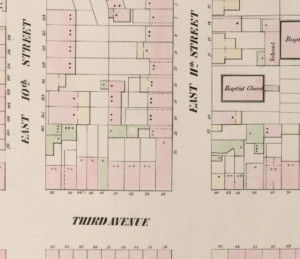
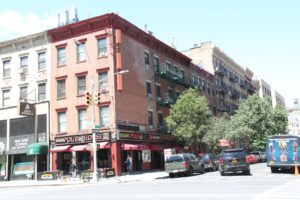 Exterior view of 122 East 11th Street and 64 Third Avenue, showcasing the combined structure of former row houses
Exterior view of 122 East 11th Street and 64 Third Avenue, showcasing the combined structure of former row houses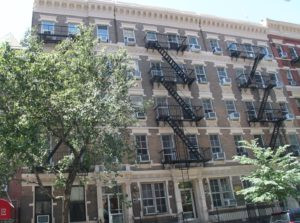 Exterior of 116-120 East 11th Street, showcasing the Beaux-Arts architectural style of the tenement buildings
Exterior of 116-120 East 11th Street, showcasing the Beaux-Arts architectural style of the tenement buildings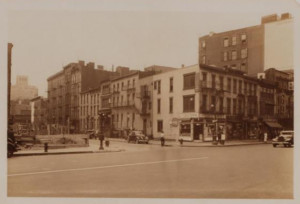 Historic photograph of East 11th Street looking southeast from Fourth Avenue, taken in June 1936, from the NYPL archives
Historic photograph of East 11th Street looking southeast from Fourth Avenue, taken in June 1936, from the NYPL archives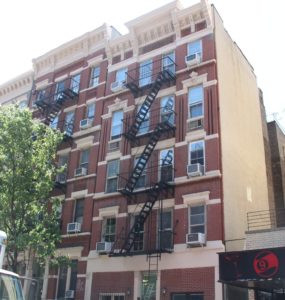 Street view of 112 and 114 East 11th Street, highlighting the architectural details of these early 20th-century tenements
Street view of 112 and 114 East 11th Street, highlighting the architectural details of these early 20th-century tenements Exterior of the Cooper Station Post Office, showcasing its Classical Revival architecture and curved facade
Exterior of the Cooper Station Post Office, showcasing its Classical Revival architecture and curved facade